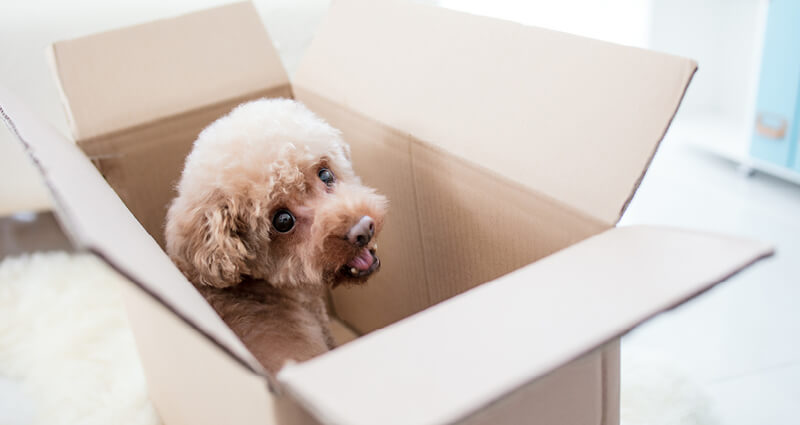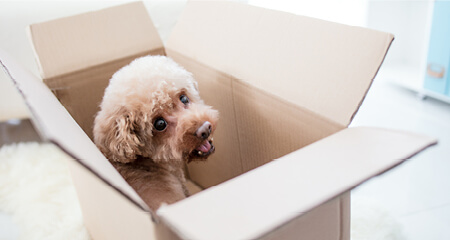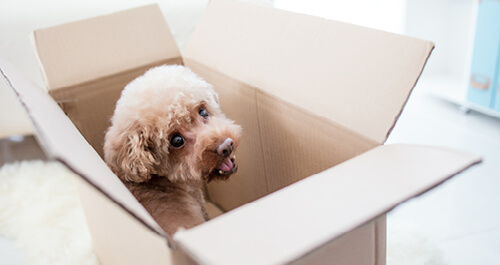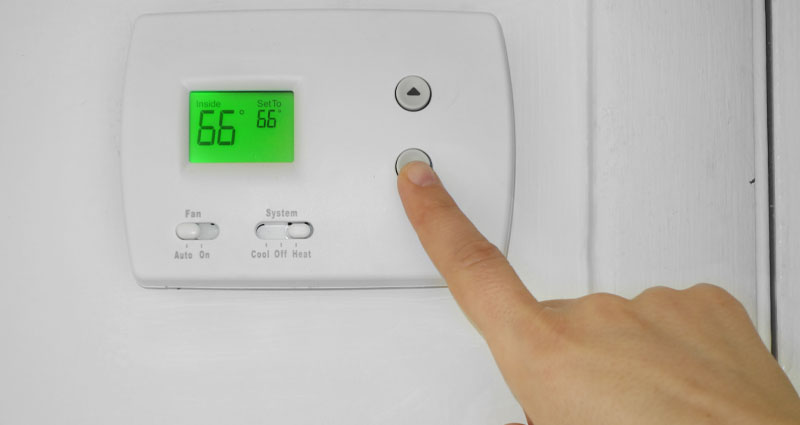Before the move: Pet preparation
If you're moving out of the area, contact your vet so you can take your pet’s records and any prescription medications with you, and be sure your pet is up to date on vaccinations. If you don't have a current health certificate for your pet handy during interstate travel, ask your vet to provide one. This document is required to transport pets across state lines. This is also a good time to ask your vet if they can recommend another vet in your new neighborhood. After you move, make sure you update your pet’s tags or microchip information with your new address and phone number.
Prepare an easily-accessible moving day kit that includes a gallon of water and enough pet food, kitty litter, toys, and grooming tools to sustain your pet and keep them comfortable during the first few days of unpacking. You'll also need to bring a pet first aid kit and some extra towels in case of accidents. Place temporary ID tags with your new address and phone number on your pet’s collar.
Many pets haven’t spent much time in crates or cars. In the weeks or months leading up to the move gradually acclimate them to their crates by placing their food inside, and start carrying them around the house or take them on a short drive in their crates.
While moving with pets usually refers to moving with a cat or dog, they're not the only animals who require extra care when relocating to a new environment. Each year, millions of families move with their favorite tarantula, iguana, fish, bird, or other exotic pet. Here is a quick breakdown of what is required to move pets other than cats or dogs:
- Fish – fish respond strongly to stress and a move can be traumatizing, if not fatal. For short distances, you can transport them in bags filled with their old tank water. (Check with your local aquarium store for supplies and more details.) Most major aquarium supply stores will supply large plastic bags infused with concentrated oxygen and water that can support fish for approximately 24 hours.
- Birds – like most pets, birds are very jittery about change. Take your bird to the vet for a checkup and obtain the necessary documents to move your feathered friend. Prepare an appropriate carrier and help them adjust to their temporary home.
- Guinea pigs – these pets are known to suffer from changed-induced stress or being jostled around. Make sure they are transported in a warm, comfortable small carrier, and try not to travel with them for more than three hours.
- Reptiles/exotic animals – reptiles are very susceptible to temperature changes and should be handled with extreme care. Some vets will loan a professional carrier to secure your lizard, spider, or snake during a move. Moving reptiles and other exotic animals can be difficult if you're planning on a long-distance move. They require special handling, so contact a professional that specializes in transporting exotic animals if your pet needs to be shipped or delivered.
If you can't take your pet with you during the move, there are a variety of animal relocation companies that will transport your animal using either their own vehicles or by prearranging appropriate relocation methods and boarding.
During the move: Pet separation
On the day of the move, keep your pets away from all the action. Place your cats or other small animals in their carriers and confine your dogs to one room or the backyard. Another option would be to ask a friend to watch your pets or place them in a kennel until all your belongings are packed away. Keeping them in the quietest area possible will help reduce stress. Make sure you check on them regularly and try to feed or walk them at the time you usually would; having some sense of a routine during all the changes will help a lot.
Once everything is out of the house, you can retrieve your pet and place them in the car or moving truck. Cats and small dogs can be put in a carrier in the back seat, which can then be secured with a seatbelt. A bigger dog can be moved in a kennel in the back of the car; you may need to put seats down if possible. Some animals feel more comfortable if you throw a blanket over their carrier during the car ride so they can't see the environment changing outside.
After the move: Pet orientation
If possible, arrange to have the electricity turned on in your new home a day or so before you arrive. You will be able to adjust the climate in your home to keep your family and pets comfortable during the move. Choose an electricity provider in your area and contact them two to three weeks prior to your move date to set up services.
Once you’ve arrived at your new home, it is best to keep your pets secure and not let them roam the house immediately. If possible, set up the house as much as you can while keeping them in a single room or secluded area. Place their favorite toys, treats, water, food, etc. in the area while they gradually adjust to their new surroundings.
This will give you time to finish moving in and “pet-proof” the house. Be sure to check for open windows, improperly stored chemicals, loose cords, and pest-control poison traps, and repair any open holes where your pet can get stuck. Your pet will be able to explore their new home once all the boxes and furniture have been moved in and the movers are gone.
Place familiar objects in similar locations as in your previous home and try to maintain their usual routine to help ease your animal’s anxiety. When they seem comfortable, gradually introduce them to other rooms in the house while keeping some doors shut.
During the entire moving process, it is important for you to remain as calm as possible. Your pet picks up on your stress, so how your pet responds to the change is going to depend on you. Every pet has his own unique personality, and you know him best, so let your animal’s behavior be your guide to determine how he’s adjusting to his new home. Taking these steps will make moving with pets much more comfortable for you and your furry (or not-so-fury) friends.



































